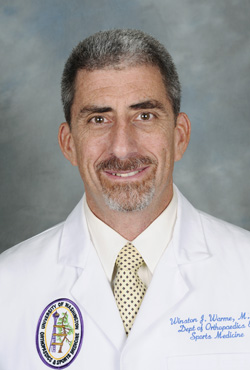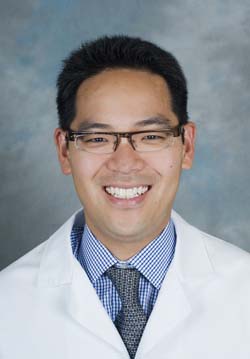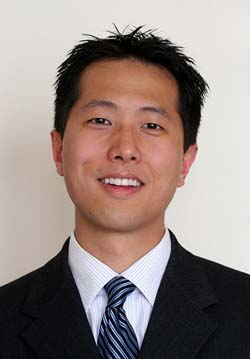Last updated: February 4, 2013
Edited by:

Associate Professor,
UW Orthopaedics & Sports Medicine

Professor,
UW Orthopaedics & Sports Medicine

Assistant Professor,
UW Orthopaedics & Sports Medicine

Assitant Professor,
UW Orthopaedics & Sports Medicine
Contact
If you have questions regarding the ream and run procedure, feel free to email Frederick A. Matsen III M.D. at matsen@uw.edu.
Overview
A Bankart repair is usually successful in stabilizing a shoulder with recurring dislocations. However sometimes surgery can fail to stabilize the shoulder either because the repair is not strong enough or because the socket of the shoulder is compromised. In these situations a contoured bone graft may provide the needed stability by deepening the socket.
After performing a careful history and a clinical examination a surgeon experienced in complex reconstructions for instability can determine if socket deficiency is contributing to the recurrent dislocations of the shoulder. Patients are most likely to benefit from this surgery if they are well motivated in good health and have not been smoking.
Figure 1 - Anatomically Contoured Extracapsular Iliac Crest Bone Graft: Bone graft inserted at the front of the glenoid socket helps restore shoulder stability. Click image to enlarge.
The goal of the bone graft surgery is to build up the socket so that it provides more stability for the joint.
The bone graft is harvested from the iliac crest (hip bone at the belt line) shaped and then screwed to the front of the socket. It is placed outside the capsule of the shoulder so that the bone graft does not rub directly on the cartilage of the humeral head (the ball of the shoulder joint).
Anatomically contoured iliac crest grafting is a highly technical procedure and is best performed by a surgical team who performs this surgery often. Such a team can maximize the benefit and minimize the risks. The two-hour procedure is performed under general (or nerve block) anesthesia. If a shoulder nerve block is used additional anesthesia is needed for the graft donor site.
Shoulder motion is started immediately after the procedure. Patients learn to do their own physical therapy and are usually discharged three days after surgery if they are comfortable and have a good range of passive motion. The recovery of strength and function may continue for up to a year after surgery.
Articles of interest on Anterior inferior Bone Grafting (PDF)
Characteristics of failed surgery for anterior dislocation
After failed surgery for anterior dislocation there is often a deficiency of the normal lip of the glenoid (shoulder socket) as well as a deficiency in the glenoid labrum and capsule (the soft tissues in front of the shoulder socket). These deficiencies make another try at a routine repair less likely to succeed.
Individuals with failed shoulder repairs usually notice that the ball slips forward out of the socket sometimes with the arm relaxed at the side and sometimes when the arm is raised backwards. The shoulder may dislocate at night as well.
There may be a grinding feeling as the arm is moved.
Once the surgery has failed dislocation of the joint may become easier and easier.
Similar conditions
Failed surgery for instability is usually not difficult for the patient to recognize. Commonly the symtoms are similar to those before the surgery--sometimes they are even worse.
Incidence and risk factors
Surgery for anterior dislocation of the shoulder fails in one out of ten to one out of twenty cases. There is a higher incidence of failure when the repair has been done arthroscopically. There is also a higher incidence of failure in individuals who smoke those who begin using their shoulder vigorously very early after the repair and those with very loose ligaments. If part of the lip of the socket is missing conventional repairs have a higher chance of failure.
Diagnosis
The shoulder surgeon diagnoses failure of surgery for anterior dislocation from the patient's history performing a thorough physical examination of the joint and taking the proper X-rays.
The examination often reveals that the shoulder slips easily out of the front of the socket even when it is pressed into it. This is called the "load and shift test." It is similar to checking the adequacy of a golf tee by pressing the golf ball into it and seeing how easily the golf ball can slide out of the tee.
X-rays of the shoulder may reveal that bony lip of the glenoid socket is rounded or deficient. They may also reveal that the humeral head (ball) is not centered in the glenoid (socket).
Medications
Medications are usually not helpful in improving the stability of the shoulder joint after failed surgery.
Exercises
Exercises can help to stabilize the shoulder. Particularly internal and external rotation strengthening exercises and exercise that develop coordinated movements may increase the joint's stability.
However if the shoulder is unstable at rest or at night exercises may not be of benefit.
Possible benefits of surgery to deepen the socket of anteriorly dislocating shoulders (using an anterior iliac crest bone graft)
If the cause of recurrent instability after a previous repair for anterior dislocation is a deficiency of the lip of the socket or lack of soft tissues of sufficient strength an anatomically contoured extracapsular bone graft harvested from the iliac crest (hip at the beltline) may restore stability by deepening the socket. In experienced hands this procedure may help restore function of the unstable shoulder.
While this surgery can improve stability it cannot make the joint as good as it was before the onset of dislocations. In many cases the tendons and muscles around the shoulder have been weakened from prolonged disuse and recurring dislocations.
After the surgery it may take months of gentle exercises before the shoulder achieves maximum improvement in comfort and function.
The effectiveness of the procedure depends on the health and motivation of the patient the condition of the shoulder and the experience of the surgeon.
Types of surgery recommended
When the anterior soft tissues of the shoulder are deficient particularly if there is loss of the bone from the front of the socket iliac crest grafting to the anterior glenoid lip provides the most robust of reconstruction techniques.
Other procedures such as a repeat Bankart repair may be of benefit if the bony anatomy is normal and if adequate quantity and quality of soft tissues remain.
Not all surgical cases are the same, this is only an example to be used for patient education.
Shoulder fusion can stabilize the shoulder but takes away the mobility at the ball and socket joint.
Who should consider surgery to deepen the socket of anteriorly dislocating shoulders (using an anterior iliac crest bone graft)?
Iliac crest graft surgery is considered when dislocations or instability of the shoulder have recurred after previous surgery for dislocations.
If the patient and doctor decide to use this surgical procedure it is important that:
- the instability is the problem
- the patient is sufficiently healthy to undergo the procedure
- the patient understands and accepts the risks and alternatives
- the surgeon is experienced in shoulder reconstructive surgery and
- the patient is dedicated to the rehabilitation program after the surgery.
What happens without surgery?
If the shoulder dislocates repeatedly the dislocations tend to become more frequent and to require less force.
Recurrent dislocations may cause risk to the bone the rotator cuff and to the nerves and blood vessels in front of the joint.
Surgical options
Several options exist for the patient with failed shoulder instability surgery.
One is to accept the tendency for dislocation and to control it with careful positioning of the shoulder and with exercises.
A second option is for the surgeon to attempt a repeat soft tissue repair assuming there is sufficient and sufficiently strong tissue.
The third option is to perform an anatomically contoured extracapsular iliac crest bone graft to the anterior glenoid lip.
A final option is to perform a fusion of the shoulder.
Effectiveness
If the problem is recurrent anterior glenohumeral instability after surgery anterior iliac crest grafting is usually very effective in restoring stability. Once the glenoid graft is healed solidly (usually after 3 months) the stability should not be lost with time unless a new injury occurs.
Urgency
Surgery for failed instability surgery is an elective procedure that can be scheduled when circumstances are optimal. It is not an urgent procedure. The patient has plenty of time to become informed and to select an experienced surgeon.
Risks
The risks of iliac crest grafting to the anterior glenoid lip include but are not limited to the following:
- infection
- injury to nerves and blood vessels
- fracture
- stiffness or instability of the joint
- loosening or wear of the bone graft
- screw loosening
- arthritis
- and problems at the bonegraft harvest site.
There are also risks to anesthesia.
A blood transfusion is only rarely required.
An experienced shoulder replacement team will use special techniques to minimize these risks but cannot totally eliminate them.
Managing risk
Most of the risks of iliac crest graft surgery can be effectively managed if they are identified promptly and treated. Infections may require a wash out in the operating room possibility with removal of the graft. Blood vessel or nerve injury may require repair. Fracture may require surgical fixation. Stiffness or instability may require exercises or additional surgery. Loosening of hardware or wear of the graft may require surgical revision. Arthritis of the shoulder may require joint reconstruction. If the patient has questions or concerns about the course after surgery the surgeon should be informed as soon as possible.
Preparation
Iliac crest graft surgery is considered for healthy and motivated individuals in whom instability after a previous repair interferes with shoulder function.
Successful reconstructive surgery depends on a partnership between the patient and the experienced shoulder surgeon. Patients should optimize their health so that they will be in the best possible condition for this procedure. Smoking should be stopped a month before surgery and not resumed for at least three months afterwards. Any heart lung kidney bladder tooth or gum problems should be managed before surgery. Any infection may be a reason to delay the operation. The shoulder surgeon needs to be aware of all health issues including allergies and the non-prescription and prescription medications being taken. Some of these may need to be modified or stopped. For instance aspirin and anti-inflammatory medication may affect the way the blood clots.
The area of the skin incision over the shoulder and hip must be clean and free from sores and scratches.
Before surgery patients should consider the limitations alternatives and risks of surgery. Patients should also recognize that the result of surgery depends in large part on their efforts in rehabilitation after surgery.
The patient needs to plan on being less functional than usual for six to twelve weeks after the procedure. Driving shopping and performing usual work or chores may be difficult during this time. Plans for necessary assistance need to be made before surgery. For individuals who live alone or those without readily available help arrangements for home help should be made well in advance.
Timing
Shoulder reconstruction with an iliac crest graft can be delayed until the time that is best for the patient's overall well-being. However in the case of recurrent dislocations excessive delays can result in the loss of bone and tendon tissue. These losses can compromise the quality of the surgery and its result.
Costs
The surgeon's office should provide a reasonable estimate of:
- the surgeon's fee and
- the hospital fee
Surgical team
Revision instability surgery is a technically demanding procedure that should be performed by an experienced surgeon in a medical center accustomed to performing these reconstructions frequently. Patients should inquire as to the number of similar shoulder procedures that the surgeon performs each year and the number of these procedures performed in the medical center each year.
Finding an experienced surgeon
Because these procedures are performed infrequently in the United States each year it is unlikely that every community has a shoulder surgeon who performs many of these procedures each year. Surgeons specializing in shoulder joint reconstruction may be located through university schools of medicine county medical societies or state orthopedic societies. Other resources include local rheumatologists or professional societies such as the American Shoulder and Elbow Surgeons Society which offers a worldwide directory of shoulder and elbow surgeons on its web site.
Facilities
Shoulder reconstruction is usually performed in a major medical center that performs these procedures on a regular basis. These centers have surgical teams and facilities specially designed for this type of surgery. They also have nurses and therapists who are accustomed to assisting patients in their recovery from shoulder reconstruction surgery.
Technical details
Revision surgery for shoulder instability is a highly technical procedure; each step plays a critical role in the outcome.
After the anesthetic has been administered and the shoulder and hip are prepared an incision is made across the front of the shoulder. The incision from a previous repair may be used for this procedure. Otherwise an incision is made in the anterior skin crease of the shoulder.
The hip incision is made just below the beltline near the front of the hip.
The shoulder incision allows access to the joint without damaging the important deltoid or pectoralis muscles that are responsible for a significant portion of the shoulder's power.
The muscles and other tissues near the shoulder are mobilized by removing any scar tissue that may restrict their motion. This may be difficult if previous surgery has resulted in excessive scarring or if implants or sutures need to be removed and dissected from the normal tissues.
The subscapularis tendon is cut to allow access to the joint and then split from the capsule that lies beneath it. This split reveals the front of the bone of the socket where the bone graft will be placed and secured.
The graft is then harvested from the iliac crest by detaching the muscles that attach there. A segment of bone measuring about 4 cm by 4 cm by 1 cm is harvested. The muscles are then reattached.
This bone graft is then shaped to fit on the front of the glenoid and fixed there with two screws. The graft is placed so that the capsule lies between the humeral head and the graft. After the graft has been secured in position its contour can be finely adjusted.
After the graft is in position the stability of the shoulder is examined. At the conclusion of the procedure the subscapularis tendon and capsule are repaired.
Anesthetic
Revision instability surgery may be performed under a general anesthetic or under a brachial plexus nerve block. A brachial plexus block can provide anesthesia for several hours after the surgery. If a plexus block is used additional anesthesia is necessary for the iliac crest harvest. The patient may wish to discuss their preferences with the anesthesiologist before surgery.
Length of surgery to deepen the socket of anteriorly dislocating shoulders (using an anterior iliac crest bone graft)
The procedure usually takes approximately two hours however the preoperative preparation and the postoperative recovery may add several hours to this time. Patients often spend two hours in the recovery room and two to four days in the hospital after surgery.
Pain and pain management
The shoulder and hip are painful after the surgery. Pain in the hip area may make walking uncomfortable for several weeks after surgery. A cane held in the opposite hand may be helpful in walking afterwards. For this reason the bone graft is usually harvested from the same side as the shoulder surgery. Recovery of comfort and function after shoulder reconstruction continues for the first year after surgery.
Use of medications
Initially pain medication is usually administered intravenously or intramuscularly. Sometimes patient controlled analgesia (PCA) is used to allow the patient to administer the medication as it is needed. Hydrocodone or Tylenol with codeine are taken by mouth. Intravenous pain medications are usually needed only for the first day or two after the procedure. Oral pain medications are usually needed only for the first two weeks after the procedure.
Effectiveness of medications
Pain medications can be very powerful and effective. Their proper use lies in the balancing of their pain relieving effect and their other less desirable effects. Good pain control is an important part of the postoperative management.
Important side effects
Pain medications can cause drowsiness slowness of breathing difficulties in emptying the bladder and bowel nausea vomiting and allergic reactions. Patients who have taken substantial narcotic medications in the recent past may find that usual doses of pain medication are less effective. For some patients balancing the benefit and the side effects of pain medication is challenging. Patients should notify their surgeon if they have had previous difficulties with pain medication or pain control.
Hospital stay
After surgery the patient spends an hour or so in the recovery room. Drainage tubes are usually used to remove excess fluid from the surgical areas. The drains are usually removed on the second day after surgery. Bandages cover the incisions. They are usually changed the second day after surgery.
Patients are discharged as soon as the incisions are dry the shoulder and hip are comfortable with oral pain medications the patient can perform the range of motion exercises the patient can walk independently and the home support systems for the patient are in place. Discharge is usually on the third or fourth day after surgery.
Recovery and rehabilitation in the hospital
Early motion after shoulder reconstruction helps achieve the best possible shoulder function. Initially the patient is encouraged to rotate the arm through a limited range that is defined by the surgeon.
During the hospitalization the patient learns the simple rehabilitation program that will be used for maintaining the range of motion at home after discharge. On the day of surgery or the day after the physical therapist teaches the patient gentle range of motion exercises. Walking and use of the arm for gentle activities are encouraged soon after surgery.
Hospital discharge
At the time of discharge the patient should be relatively comfortable on oral medications have dry incisions understand their exercises and feel comfortable with the plans for managing the shoulder and the hip. For the first month or so after this procedure the operated arm may be less useful than it was immediately beforehand.
The specific limitations can be specified only by the surgeon who performed the procedure. It is important that the repaired tendons not be challenged until they have had a chance to heal. Usually the patient is asked to lift nothing heavier than a cup of coffee for six weeks after the surgery. Management of these limitations requires advance planning to accomplish the activities of daily living during the period of recovery.
Convalescent assistance
Patients usually require some assistance with self-care activities of daily living shopping and driving for approximately six weeks after surgery. Patients usually go home after this surgery especially if there are people at home who can provide the necessary assistance or if such assistance can be arranged through an agency. In the absence of home support a convalescent facility may provide a safe environment for recovery.
Recovery of comfort and function after shoulder reconstruction continues for many months after the surgery. Improvement in some activities may be evident as early as six weeks. With persistent effort patients make progress for as long as a year after surgery.
Physical therapy
Early motion after shoulder reconstruction is critical for achieving optimal shoulder function. One of the major goals of shoulder reconstruction surgery is to maintain the range of motion while achieving stability.
After surgery scar tissue tends to limit movement unless motion is started immediately. Later on once the shoulder is comfortable and flexible strengthening exercises and additional activities are started.
Rehabilitation options
It is often most effective for the patient to carry out their own exercises so that they are done frequently effectively and comfortably. Usually a physical therapist or the surgeon instructs the patient in the exercise program and advances it at a rate that is comfortable for the patient. For the first six weeks after surgery emphasis is placed on optimizing the flexibility and range of motion of the shoulder through gentle stretching exercises. After six weeks these stretching exercises are continued and strengthening exercises may be added.
Can rehabilitation be done at home?
In general the exercises are best performed by the patient at home. Occasional visits to the surgeon or therapist may be useful to check the progress and to review the program.
Usual response
Patients are almost always satisfied with the increases in range of motion comfort and function that they achieve with the exercise program. If the exercises are uncomfortable difficult or painful the patient should contact the surgeon promptly.
Risks
The primary risk is that the patient may exceed the limitations suggested by the surgeon after the reconstruction.
Duration of rehabilitation
Once the range of motion and strength goals are achieved the exercise program can be cut back to a minimal level. However gentle stretching is recommended on an ongoing basis.
Returning to ordinary daily activities
In general patients are able to perform gentle activities of daily living using the operated arm from two to six weeks after surgery. Walking is strongly encouraged. Driving should wait until the patient can perform the necessary functions comfortably and confidently. Recovery of driving ability may take six weeks if the surgery has been performed on the right shoulder because of the increased demands on the right shoulder for shifting gears.
With the consent of their surgeon patients can often return to activities such as swimming and golf at six months after their surgery.
Long-term patient limitations
Until the surgeon determines that the shoulder is healed and strong patients should avoid sudden heavy or forceful activities with the shoulder.The surgeon and therapist should provide the information on the usual cost of the rehabilitation program. The program is quite cost-effective because it is based heavily on home exercises.
Costs
The surgeon and therapist should provide the information on the usual cost of the rehabilitation program. The program is quite cost-effective because it is based heavily on home exercises.
Summary of surgery to deepen the socket of anteriorly dislocating shoulders (using an anterior iliac crest bone graft) for failed surgery for anterior dislocation
After a procedure for anterior shoulder dislocation fails the tissues may be compromised so that another routine repair may not be dependable.
In such a situation especially if there is a loss of the normal lip of the socket and deficiency of the normal soft tissues consideration can be given to a shoulder reconstruction using a contoured iliac crest graft placed outside the shoulder capsule.
This reconstruction is best performed by a surgeon familiar with complex shoulder revision surgery.
The iliac crest graft can provide excellent stability of the shoulder.
Other options include accepting the limitations of instability attempting a repeat soft tissue procedure and a shoulder fusion.







